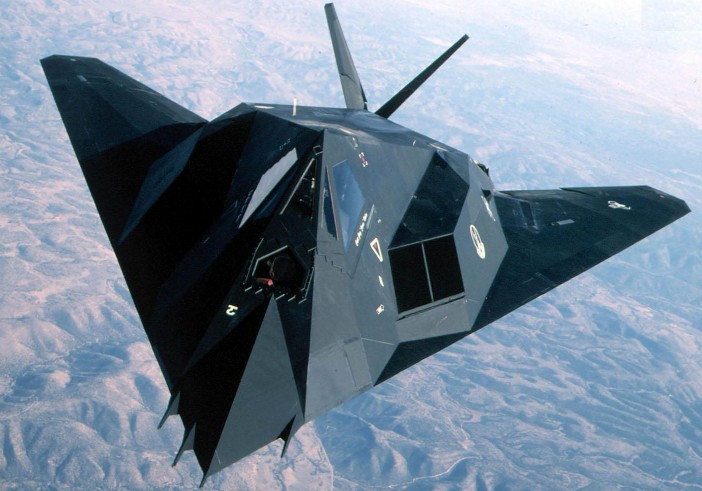The F-117A Nighthawk is the world's first operational aircraft designed to exploit low-observable stealth technology. The unique design of the single-seat F-117A provides exceptional combat capabilities. About the size of an F-15 Eagle, the twin-engine aircraft is powered by two General Electric F404 turbofan engines and has quadruple redundant fly-by-wire flight controls. Air refuelable, it supports worldwide commitments and adds to the deterrent strength of the U.S. military forces.

|
The F-117A can employ a variety of weapons and is equipped with sophisticated navigation and attack systems integrated into a state-of-the-art digital avionics suite that increases mission effectiveness and reduces pilot workload. Detailed planning for missions into highly defended target areas is accomplished by an automated mission planning system developed, specifically, to take advantage of the unique capabilities of the F-117A.
The first stealth fighters were flown by Lockheed C-5 Galaxy cargo plane to Groom Dry Lake, where they took to the air for the first time in June 1981. Security was of a very extreme nature. Unauthorized ground personnel were required to remain indoors when a stealth jet emerged from its hangar. Test flights were made mostly at night, their schedule arranged to avoid overflights by Soviet reconnaissance satellites. The Nellis Range is also home to the Air Force's "Red Flag" air combat exercises, which involve aircraft and pilots of American and several foreign military aviation services. Those other aircraft were kept away from the Groom area by an airborne screen of security aircraft.
Despite the F-117A's 33 percent increase in physical size over the prototype, the stealth fighter's RCS measured between .01 and .001 square meters - about that of a small bird. For instance, compared to a McDonnell Douglas F-4G Phantom typically used for "Wild Weasel" anti-radar missions, which has a head-on RCS of 6 square meters, the F-117 was able to get 90 percent closer to ground-based search radars, and 98 percent closer to airborne radars, before being detected.
The first F-117A was delivered in 1982. The F-117A production decision was made in 1978 with a contract awarded to Lockheed Advanced Development Projects, the "Skunk Works," in Burbank, California. The first flight was in 1981, only 31 months after the full-scale development decision. Air Combat Command's only F-117A unit, the 4450th Tactical Group, (now the 49th Fighter Wing, Holloman Air Force Base, N.M.), achieved operational capability in October 1983.
Having outgrown the Groom Lake facilities, the stealth unit operates out of the remote Tonopah Test Range airfield in the northwest corner of the Nellis Range. Although overlooked by public land, the Tonopah facility is 40 desert miles from the nearest town.
Streamlined management by Aeronautical Systems Center, Wright-Patterson AFB, Ohio, combined breakthrough stealth technology with concurrent development and production to rapidly field the aircraft. The F-117A program has demonstrated that a stealth aircraft can be designed for reliability and maintainability. The aircraft maintenance statistics are comparable to other tactical fighters of similar complexity. Logistically supported by Sacramento Air Logistics Center, McClellan AFB, California, the F-117A is kept at the forefront of technology through a planned weapon system improvement program located at USAF Plant 42 at Palmdale, California.
| DESCRIPTION: | ||
|---|---|---|
| Manufacturer: | Lockheed Aeronautical Systems Co. | |
| Designation: | F-117a Nighthawk | |
| Type: | Fighter/Bomber | |
| Unit Cost: | $45 million | |
| SPECIFICATIONS: | ||
| Length: | 65' 11" | 20.3 M |
| Height: | 12' 5" | 3.8 M |
| Wingspan: | 43' 4" | 13.3M |
| Weight: | 52000 lbs | 23625 Kg |
| PROPULSION: | ||
| No. of Engines: | 2 | |
| Powerplant: | General Electric F404 engines | |
| PERFORMANCE: | ||
| Range: | Unlimited | with refuelling |
| Max Speed: | High Subsonic | |
| ARMAMENTS: | ||
| Internal weapons carriage | ||
It has also been - falsely - claimed that the F-117A contains experimental propulsion technology or even "electro-gravitic" systems. See here for comments.